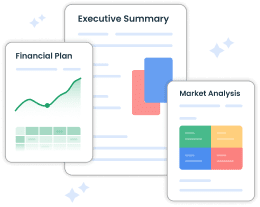Free Download
Business Plan Template for Small Businesses
Get started with our easy-to-use, SBA lender-approved business plan templates. Perfect for entrepreneurs, small businesses, and startups!
All 100% free. We're here to help you succeed in business, no strings attached.

15-Day Money Back
4.9

Our free business plan template includes
Detailed instructions
- Get clear, step-by-step instructions to craft a winning business plan.
SBA-lender approved format
- The format matches what lenders and investors expect, making it easy to review.
Fill-in-the-blanks template
- Just enter a few easy blanks and get your plan ready in minutes—no expertise needed.
Expert tips & tricks
- Grab valuable business planning tips and actionable strategies to make informed decisions.
Why use our business plan templates?
Writing a business plan from scratch isn’t an easy feat, especially when you’re doing it for the first time. After all, there are so many aspects to consider.
Where do you even start writing? What are the key elements that investors or lenders want to see? And much more.
But with our business plan templates, you can make the process less overwhelming, faster, and a lot easier whether you’re just starting out or scaling an existing firm.
Here’s what makes them so helpful:
- No Expertise Needed: Confused how to begin? Just fill-in-the-blanks and you’re good to go—no stressing over formatting or what to include.
- Customizable Formats: You can easily edit or modify these templates to fit your business needs and preferences.
- Professional Layouts: Designed with an SBA-lender-approved structure to impress investors and lenders.
- Step-by-Step Instructions: Each section involves clear instructions and guidance to walk you through the process.
- Completely Free: Yes, you heard it right—these templates are 100% free to download and use.
In short, these templates are designed to guide you through every step of the way.
What sections are included in the free business plan template?
Our downloadable templates cover all the essential details you’ll need to create a complete, professional-looking business plan.
And most importantly, a good business plan template ensures you don’t miss or skip any critical information that potential lenders and investors need to know.
Here’s a quick rundown of the sections you’ll typically find in our free templates:
1. Executive Summary
A brief overview of your entire business plan, presenting readers your business idea and what makes it unique. Though it’s an introductory part, it’s written at the end once the full plan is ready because it summarizes:
- Business concept and mission
- Problems you intend to solve
- Type of services or products you’ll offer
- Target market opportunities
- Marketing tactics
- Financial projections
2. Company Overview
Introduces your beloved company in more detail by outlining its core values and future goals. This section also details the structural components of your company, including:
- Location and legal structure
- Business model type
- Key owners
- Background history
- Goals and objectives
3. Market Analysis and Competition
An in-depth look at the market you’re going to enter, who you wish to serve, as well as the top competitors. Here’s what it covers:
- Market size and growth potential
- Your target audience
- Competitive analysis
- Emerging trends
- Regulatory requirements
Say goodbye to boring templates
Build your business plan faster and easier with AI
Plans starting from $14/month

3. Products & Services
It’s the essence of what problems you intend to address and the kind of solution you wish to offer to your customers. It includes solid details of:
- Products and services you’ll offer
- Pricing strategy
- Intellectual property or patents
- Potential future offerings
4. Marketing and Sales Strategies
This is all about showing readers your effective sales plan and the chosen marketing channels, highlighting how you’ll promote your business and generate sales.
- Unique value propositions
- Marketing plan
- Sales and distribution channels
- Customer retention strategy
5. Operations Plan
A detailed description of what makes your business run smoothly. So, it’s your chance to give stakeholders a clear picture of how your business will function on a daily basis, illustrating:
- Daily operations
- Key milestones
- Partners and resources
- Equipment & tools used
6. Organization and Management Team
This section talks about yourself (as a business owner) and your experienced management team. It emphasizes each member’s roles, responsibilities, educational qualifications, expertise, as well as professional background.
7. Financial Plan
A thorough breakdown of your business’s historical financial state and future financial projections with accurate numbers. This will help you pitch investors and secure enough funding.
In general, this section must enclose a few critical financial statements, like:
- Profit and loss statement (income statement)
- Balance sheet
- Cash flow statement
- Funding needs (if any)
- Exit strategy
8. Appendix
Well, this last section of a business plan is not mandatory. But it lets you place supporting documents or additional information that supports and strengthens the rest of your plan.
Write Your Business Plan Using Upmetrics
Now, putting together your business plan doesn’t have to be overwhelming. Just download one of these ready-made templates as per your industry-specific needs and you’re on your way to creating a solid plan.
But if you’re feeling stuck with details or seeking more assistance, try using our business planning software—Upmetrics to get a headstart!
With its advanced features and AI capabilities, it helps you develop a successful business plan that wins investors.
Start your Business plan today
Whether you’re writing a business plan to validate your business idea, secure funding, or grow your existing business – our business plan template will help you achieve your goals.

Frequently Asked Questions
Is this business plan template really free?
Yes, our business plan template is 100% free to download and use.
What formats are available for this business plan template?
This business plan template is available in multiple formats: PDF, Google Docs, and Word.
Can I customize this business plan template for my business?
Definitely; you can customize this business plan template to match your distinct business requirements and/or use it for your reference.
Who can use this simple business plan template?
Startup founders, small business owners, young entrepreneurs, or anyone needing a business plan can use this simple template to create the first draft of their plan.
Is this template suitable for funding applications or investor pitches?
Absolutely. But first, you need to tailor this business plan template according to your specific requirements. Then, understand your target audience to realize the tone and style you should use. Lastly, ensure you’re clear about your intentions by adding a funding request section in your business plan.
Can I print the business plan template?
Yes. This is a printable business plan template that you can download as a PDF or Word document. It’s already formatted and structured to meet investor or moneylender standards. So, if you modify it to fit your needs, be sure to review it carefully before printing.
Where can I get a free business plan template?
You can get a free business plan template from Upmetrics. It’s easy to use, fully customizable, and includes examples to help you get started quickly. Ideal for startups, small businesses, and entrepreneurs writing their first plan.
What if I need additional help with my business plan?
You can start with a sample business plan (industry-specific) to create your own. But if you need additional help, we have a detailed business planning tool—Upmetrics to help you further.
Do you offer additional tools or resources?
Accordion Of course! We offer additional tools, like AI Business Plan Generator, financial forecasting software, AI pitch deck creator, strategic business plan canvas templates, guided business plan builder, and easy-to-follow guides.
Download Your Business Plan Template Now
Resources to plan, launch, and grow your business.
- Detailed instructions
- Fill-in-the-blanks template
- User-friendly layout
- Expert tips & tricks
Your business plan template is ready
Download your resource now. It's the perfect starting point to start building your business.
- All 100% free. We're here to help you succeed.

Need assistance planning your business?
Plan, Launch, and Grow Your Business with Upmetrics AI.
